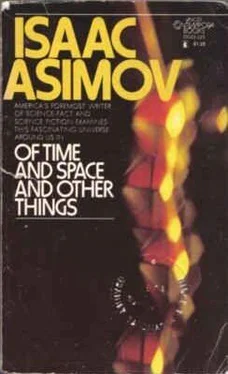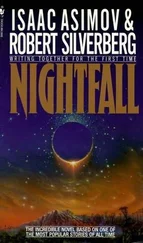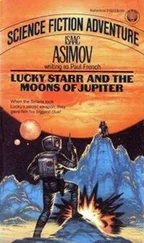Isaac Asimov - Of Time and Space and Other Things
Здесь есть возможность читать онлайн «Isaac Asimov - Of Time and Space and Other Things» весь текст электронной книги совершенно бесплатно (целиком полную версию без сокращений). В некоторых случаях можно слушать аудио, скачать через торрент в формате fb2 и присутствует краткое содержание. Год выпуска: 1972, ISBN: 1972, Издательство: Lancer Books, Жанр: Прочая научная литература, на английском языке. Описание произведения, (предисловие) а так же отзывы посетителей доступны на портале библиотеки ЛибКат.
- Название:Of Time and Space and Other Things
- Автор:
- Издательство:Lancer Books
- Жанр:
- Год:1972
- ISBN:ISBN: 0-447-33023-3
- Рейтинг книги:4 / 5. Голосов: 1
-
Избранное:Добавить в избранное
- Отзывы:
-
Ваша оценка:
- 80
- 1
- 2
- 3
- 4
- 5
Of Time and Space and Other Things: краткое содержание, описание и аннотация
Предлагаем к чтению аннотацию, описание, краткое содержание или предисловие (зависит от того, что написал сам автор книги «Of Time and Space and Other Things»). Если вы не нашли необходимую информацию о книге — напишите в комментариях, мы постараемся отыскать её.
Of Time and Space and Other Things — читать онлайн бесплатно полную книгу (весь текст) целиком
Ниже представлен текст книги, разбитый по страницам. Система сохранения места последней прочитанной страницы, позволяет с удобством читать онлайн бесплатно книгу «Of Time and Space and Other Things», без необходимости каждый раз заново искать на чём Вы остановились. Поставьте закладку, и сможете в любой момент перейти на страницу, на которой закончили чтение.
Интервал:
Закладка:
Well, then, why is the night sky black? We're back to that.
Let's try another tack. Astronomers can determine whether a distant luminous object is approaching us- or receding from us by studying its spectrum (that is, its lijzht as spread out in a rainbow of wavelengths from short wavelength violet to long-wavelength red).
The spectrum is crossed by dark lines which are in a fixed position if the object is motionless with respect to us. If the object is approaching us, the lines shift toward the violet. If the object is receding from us, the lines shift toward the red. From the size of the shift astronomers can determine the velocity of approach or recession.
In the 1910s and 1920s the spectra of some galaxies (or bodies later understood to be galaxies) were studied, and except for one or two of the very nearest, all are re ceding from us. In fact, it soon became apparent that the farther galaxies are receding more rapidly than the nearer ones. Hubble was able to formulate what is now called "Hubble's Law" in 1929. This states that the velocity of recession of a galaxy is proportional to its distance from us. If Galaxy A is twice as far as Ga laxy D, it is receding at twice the velocity. The farthest observed galaxy, 6,000, 000,000 light-years from us, is receding at a velocity half that of light.
The reason for Hubble's Law is taken to lie in the ex pansion of the universe itseff-an expansion which can be made to follow from the equations set up by Einstein's General Theory of Relativity (which, I hereby state firmly, I will not go into).
Given the expansion of the universe, now, how are Olbers' assumptions affected?
If, at a distance of 6,000,000,000 light-years a galaxy recedes at half the speed of light, then at a distance of 12,000,000,000 light-years a galaxy ought to be receding at the speed of light (if Hubble's Law holds). Surely, further distances are meaningless, for we cannot halve velocities greater than that of light. Even if that were pos sible, no light, or any other "message" could reach us from such a more-distant galaxy and it would not, in effect, be in our universe. Consequently, we can imagine the universe to be finite after all, with a "Hubble radius" of some 12,000,000,000 light-years.
But that doesn't wipe out Olbers' paradox. Under the requirements of Einstein's theories, as galaxies move faster and faster relative to an observer, they become shorter and shorter in the line of travel and take up less and less space, so that there is room for larger and larger numbers of galaxies. In fact, even in a finite universe, with a radius of 12,000,000,000 light-years, there might still be an in finite number of galaxies; almost all of them (paper-thin) existing in the outermost few miles of the Universe-sphere.
So Assumption 2 stands even if Assumption I does not; and Assumption 2, by itself, can be enough to insure a star-bright sky.
But what about the red shift?
Astronomers measure the red shift by the change in position of the spectral lines, but those lines move only because the entire spectrum moves. A shift to the red is a shift in the direction of lesser energy. A receding galaxy delivers less radiant energy to the Earth than the same galaxy would deliver if it were standing still relative to us - just because of the red shift. The faster a galaxy recedes the less radiant energy it delivers. A galaxy receding at the speed of light delivers no radiant energy at all no matter how bright it might be.
Thus, Assumption 3 falls! It would hold true if the uni verse were static, but not if it is expanding. Each succeed ing shell in an expanding universe delivers less light than the one within because its content of galaxies is succes sively farther from us; is subjected to a successively greater red shift; and falls short, more and more, of the expected radiant energy it might deliver.
And because Assumption 3 fails, we receive only a finite amount of energy from the universe and the night sky is black.
According to the most popular models of the universe, this expansion will always continue. It may continue with out the production of new galaxies so that, eventually, billions of years hence, our Galaxy (plus a few of its neighbors, which together make up the "local cluster" of galaxies) will seem alone in the universe. AU the other galaxies will have receded too far to detect. Or new galaxies may continuously form so that, the universe will always seem full of galaxies, despite its expansion. Either way, however, expansion will continue and the night sky will remain black.
There is another suggestion, however, that the universe oscillates; that -the expansion will gradually slow down until the universe comes to a moment of static pause, then begins to contract again, faster and faster, till it tightens at last into a small sphere that explodes and brings about a new expansion.
If so, then as the expansion slows the diinming effect of the red shift will diminish and the night sky will slowly brighten. By the time the universe is static the sky will be uniformly star-brigbt as Olbers' paradox required. Then, once the universe starts contracting, there will be a "violet shift" and the energy delivered will increase so that the sky will become far brighter and still brighter.
This will be true not only for the Earth (if it still existed in the far future of a contracting universe) but for any body of any sort in the universe. In a static or, worse still, a contracting universe there could, by Olbers' paradox, be no cold bodies, no solid bodies. There would be uniform high temperatures everywhere-in the millions of degrees, I suspect-and life simply could not exist.
So I get back to my earlier statement. The reason there is life on Earth, or anywhere in the universe, is simply that the'distant galaxies are moving away from us.
In fact, now that we know the ins and outs of Olbers' paradox, might we, do you suppose, be able to work out the recession of the distant galaxies as a necessary conse quence of the blackness of the night sky? Maybe we could amend the famous statement of the French philosopher Rene Descartes.
He said, "I think, therefore I am!"
And we could add: "I am, therefore the universe ex pandsl"
10. A Galaxy At A Time
Four or five'vears ago there was a small fire at a school two blocks from my house. It wasn't much of a fire, really, producing smoke and damaging some rooms in the base ment, but nothing more. What's more, it was outside school hours so that no lives were in danger.
Nevertheless, as soon as the first piece of fire apparatus was on the scene the audience had begun to gather. Every idiot in town and half the idiots from the various con tiguous towns came racing down to see the fire. They came by auto and by oxcart, on bicycle and on foot. They came with girl friends on their arms, with aged parents on their shoulders, and with infants at the breast.
They parked all the streets solid for miles around and after the first fire engine had come on the scene nothing more could have been added to it except by helicopter.
Apparently this happens every time. At every disaster, big or small, the two-legged ghouls gather and line up shoulder to shoulder and chest to back. They do this, it seems, for two purposes: a) to stare goggle-eyed and slack-jawed at destruction and misery, and b) to prevent the approach of the proper authorities who are attempting to safeguard life and property.
Naturally, I wasn't one of those who rushed to see the fire and I felt very self-righteously noble about it. How ever (since we are all friends), I will confess that this is not necessarily because I am free of the destructive in stinct. It's just that a messy little fire in a basement isn't my idea of destruction; or a good, roaring blaze at the munitions dump, either.
Читать дальшеИнтервал:
Закладка:
Похожие книги на «Of Time and Space and Other Things»
Представляем Вашему вниманию похожие книги на «Of Time and Space and Other Things» списком для выбора. Мы отобрали схожую по названию и смыслу литературу в надежде предоставить читателям больше вариантов отыскать новые, интересные, ещё непрочитанные произведения.
Обсуждение, отзывы о книге «Of Time and Space and Other Things» и просто собственные мнения читателей. Оставьте ваши комментарии, напишите, что Вы думаете о произведении, его смысле или главных героях. Укажите что конкретно понравилось, а что нет, и почему Вы так считаете.












